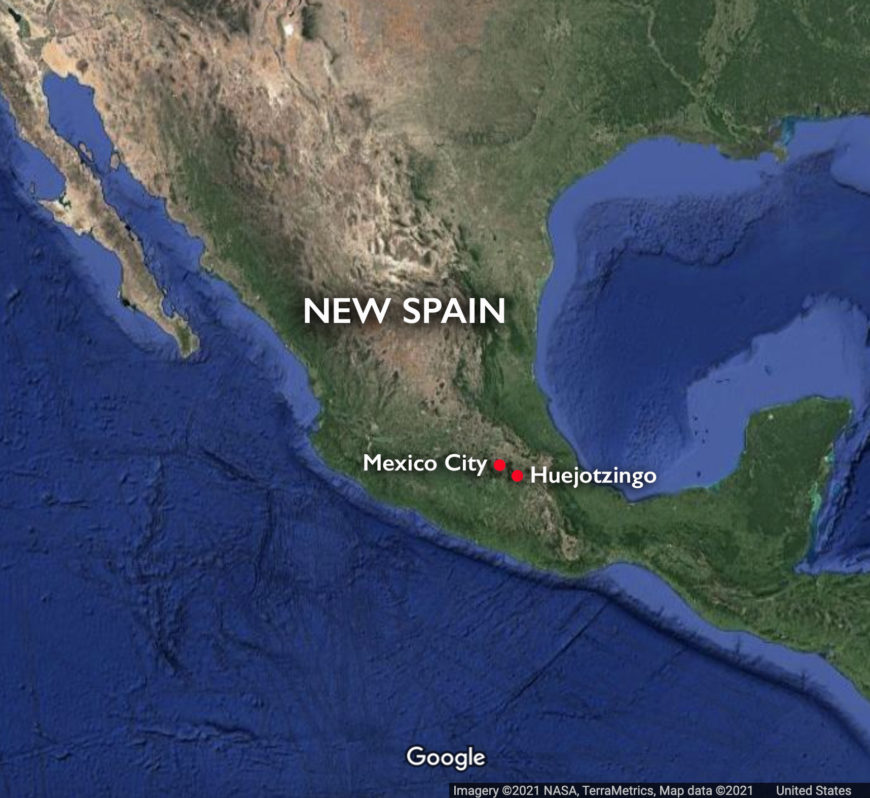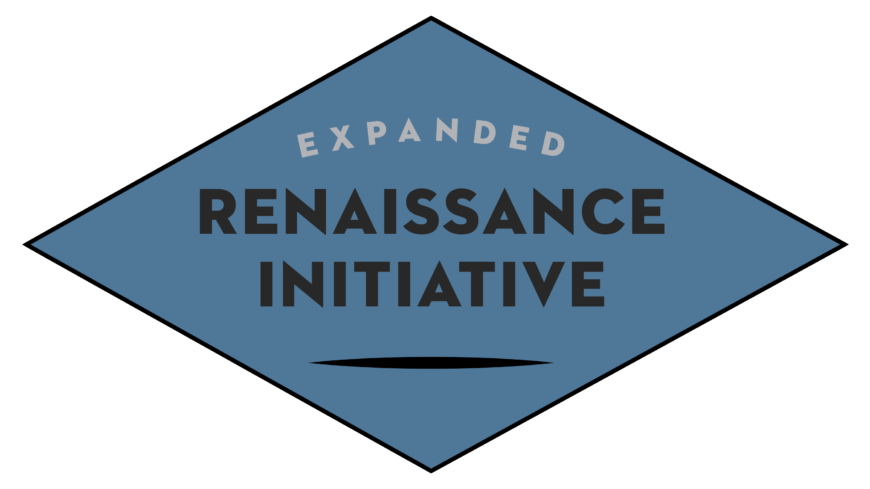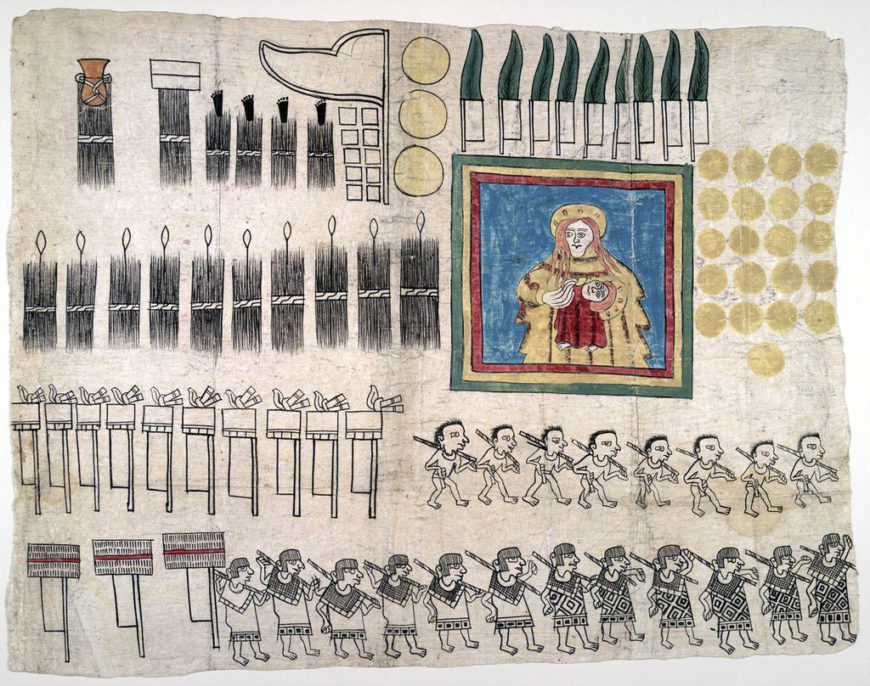
Sheet 7 of tribute, with a featherwork of the Madonna and Child, pigments on amatl paper, made by Huexotzinca artists, before 1531; then combined with written pages to form the Huexotzinco Codex, 1531 (Library of Congress)
The earliest known image of the Madonna and Child made by an Indigenous artist of the Americas shows the Virgin Mary holding the infant Christ against a blue background on a sheet of amatl paper. A frame of red, gold, and green rectangles surrounds them. Many other items also fill the page—bundles of reeds, long green feathers, golden disks, loincloths, sandals, and people—all of which initially seem disconnected from the holy image. It is unclear where we are, what these things mean, and why they are on this page together.
These images were made in the Spanish viceroyalty of New Spain by Indigenous artist-scribes (called tlacuiloque) from the town of Huejotzingo (spelled earlier as Huexotzinco) less than ten years after the Spanish Conquest in 1521. This page is a record of goods supplied by the Huexotzinca (the people of Huejotzingo) to the Spanish conquistador and administrator Nuño de Guzmán for his conquest venture to western Mexico (what would become known as Nueva Galicia after he succeeded in taking control of it). Seven other sheets of varying sizes (and in no particular order) were made along with this one as records of the services and physical goods the Huexotzinca gave to the Spaniards during a two-year time period. The eight pages form part of what is called the Huexotzinco Codex, compiled in 1531 after the image sheets and written testimonies became evidence in a court case that involved the Spanish conquistador Hernán Cortés. He claimed that during his absence (while he was in Spain), goods and services that belonged to him were appropriated by other Spaniards. The images in the Huexotzinco Codex reveal the complex situation of the early colonial period in New Spain and the ways in which Indigenous groups—like the Huexotzinca—navigated the colonial situation.
Tribute codices
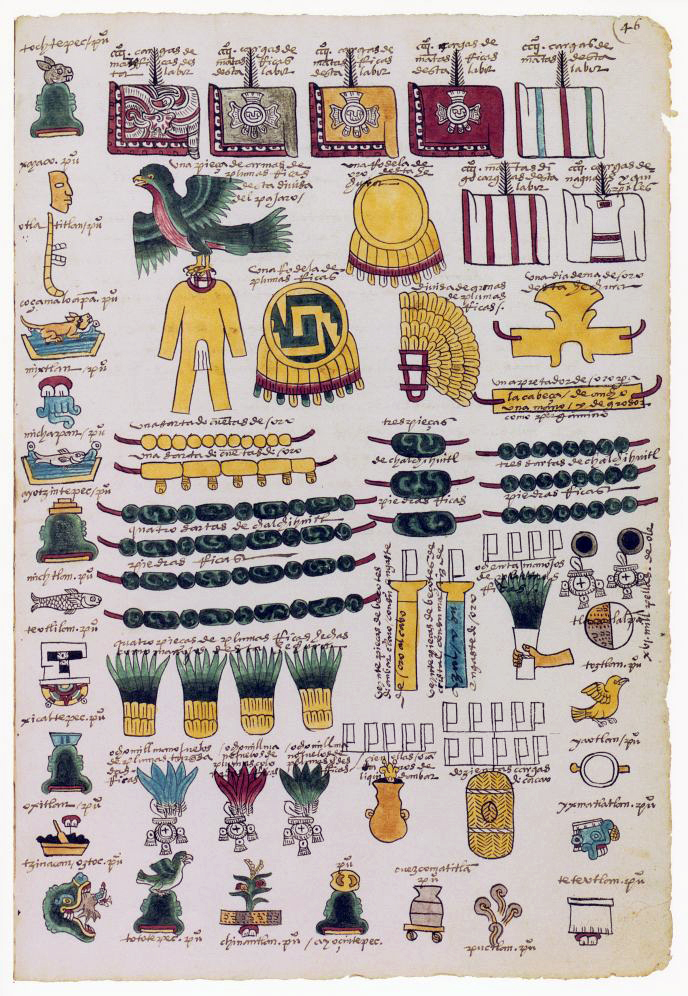
MS. Arch. Selden. A. 1, page of tribute from Tochtepec, Codex Mendoza, Viceroyalty of New Spain, c. 1541–1542 C.E., pigment on paper © Bodleian Libraries, University of Oxford
The Huexotzinco Codex belongs to a larger group of objects called tribute codices—documents that did not always take the form of an actual codex. These are documents made by Indigenous peoples that visually recorded the tribute items they were forced to pay, and they were made both pre- and post-Conquest.
Other well-known tribute lists include the Matrícula de Tributos (likely made before the Conquest, and with Spanish annotations added later) and the Codex Mendoza (mid-16th century, and modeled on the Matrícula de Tributos or a lost prototype), both of which include pages illustrating the tribute that different conquered groups were forced to pay to the Mexica Empire (as opposed to Spaniards in the Codex Huexotzinco). In one folio in the Codex Mendoza showing the tribute paid annually and semi-annually from Tochtepec (a province in southern Veracruz and northern Oaxaca), we see cloaks, warrior costumes, feathers, golden objects, greenstone beads and jewelry, rubber balls, cacao and more—all of which totaled more than 30,000 items.
In the Huexotzinco Codex, written testimonies that now accompany the images note that the Huexotzinca created the sheets to document what they felt was excessive tribute that they were forced to give to Nuño de Guzmán, Juan Ortiz de Matienzo, and Diego Delgadillo—members of New Spain’s high court (called the First Audiencia)—during Cortés’s absence. The Audiencia was actually created to check the power that Cortés had accrued during and after the Conquest. The sheets in the Codex Huexotzinco likely survive because they were used as evidence in Cortés’s lawsuit to reclaim what he felt had been taken from him by these three men of the Audiencia.
The legal dispute and the formation of the Codex
During Cortés’s initial inland march toward the city of Tenochtitlan in 1519, he had encountered the Huexotzinca, who would ally themselves with Cortés—they were no allies of the expansionist Mexica at this time who tried to control them. Thousands of Indigenous peoples (not only the Huexotzinca) would forge alliances with Cortés to defeat the Mexica Empire (as opposed to the myth that it was just a few hundred Spanish conquistadors). After the fall of the Mexica, the Huexotzinca received benefits from the Spanish Crown. They appealed to the Crown for tax exemptions, citing their early alliance with Spanish forces as evidence of their loyalty.
After the Conquest, Cortés was granted Huejotzingo, along with services and goods to be provided by the Huexotzinca. In the legal case, Cortés claimed that in 1528—when he returned to Spain—Guzmán, Ortiz de Matienzo, and Delgadillo took what rightfully belonged to him. With so many goods and services listed across eight sheets, we can imagine Cortés’s displeasure to see others take what he felt was his.
Luckily for Cortés, the people of Huejotzingo had created the paintings that recorded the goods and services they gave as tribute for the two years of his absence, and Cortés’s lawyer requested them as evidence. From Huejotzingo the documents traveled to Mexico City along with three Huexotzinca witnesses. Their testimonies—spoken in Nahuatl and translated into Spanish—were written down as they were shown the image sheets and asked to talk about them. The written testimonies were recorded on more than 70 sheets of paper that came from Italy unlike the local materials on which the images were drawn. The case was successful in Mexico, and retried again in Spain. Even King Charles of Spain eventually noted that two-thirds of all the tribute extracted from the Huexotzinca should be returned to Cortés.
Eventually the pages of text and images were combined together to form the Codex Huexotzinco. The image sheets are larger than the written text pages, so they were folded and sewn into the center of the codex (although now they have been conserved and all creases removed).
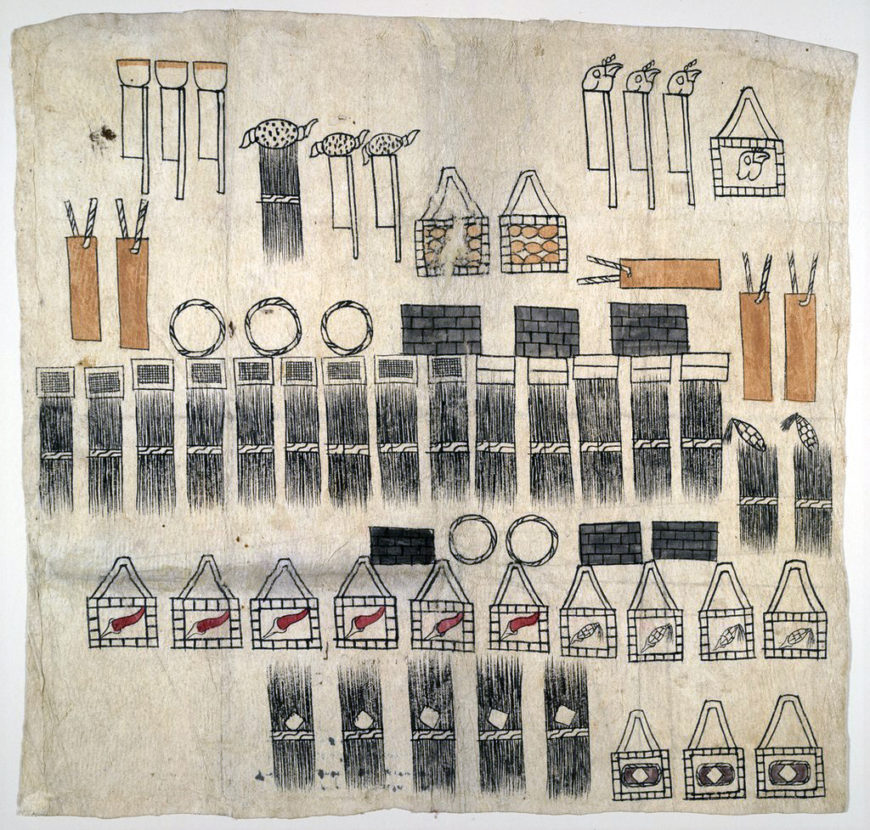
Sheet 2 of tribute, pigments on amatl paper, made by Huexotzinca artists, before 1531; then combined with written pages to form the Huexotzinco Codex, 1531 (Library of Congress)
Tribute
Each of the sheets displays rows of tribute given to Guzmán, Ortiz de Matienzo, and Delgadillo. The artist(s) records the tribute pictographically—in the style of Nahua manuscripts that had been made long before the invasion of, and conquest by, Spanish forces. Nahua writing used glyphs and signs to record information. Each item of tribute is shown as a glyph atop a flag, bundle of reeds, or bag. The flags, reeds, and bags were a visual shorthand for a numeric quantity of goods.
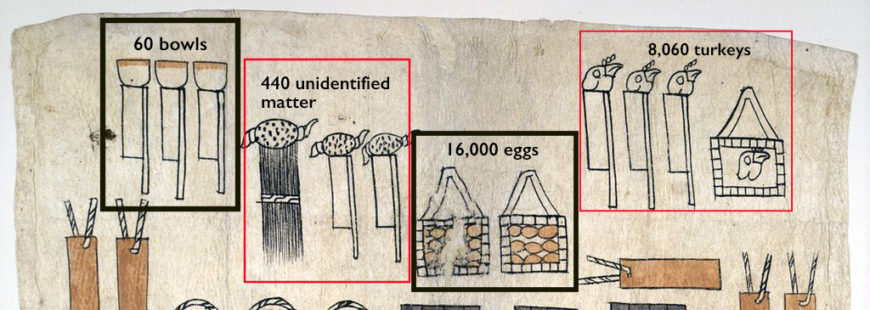
Detail of the top of sheet 2 of tribute, pigments on amatl paper, made by Huexotzinca artists, before 1531; then combined with written pages to form the Huexotzinco Codex, 1531 (Library of Congress)
The second sheet of tribute shows approximately four rows of items. On the upper left we see bowls atop flags. It is possible these are gourd bowls (xicalli). A flag was a count of 20, meaning that 60 bowls were given as tribute. To the right of the bowls are some unidentified objects that appear on a bundle of reeds and flags. A bundle was equal to 400; coupled with the two flags, the count was 440 of these items. At the center top are two bags containing eggs. A bag (xiquilli) was a count of 8,000, which means that the Huexotzinca gave 16,000 eggs! The eggs were likely turkey because chickens—not from the Americas—were not yet common. Plus, the next item of tribute is a count of 8,060 turkeys, represented by the artist with turkey heads on flags and a turkey head in a bag. Imagine all that gobbling!
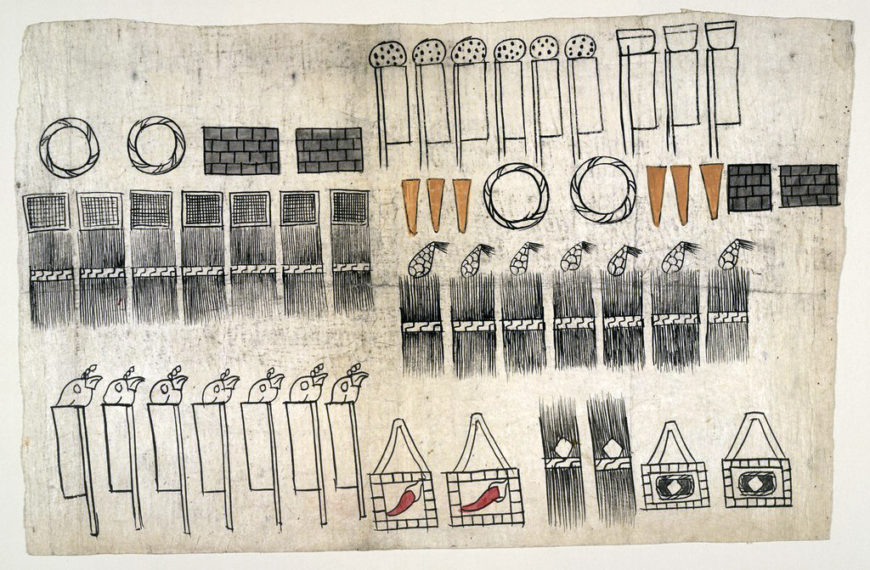
The first sheet in the Codex included construction materials for a project in Mexico City that involved building monasteries, houses, and an irrigation ditch. Pigments on amatl paper, made by Huexotzinca artists, before 1531; then combined with written pages to form the Huexotzinco Codex, 1531 (Library of Congress)
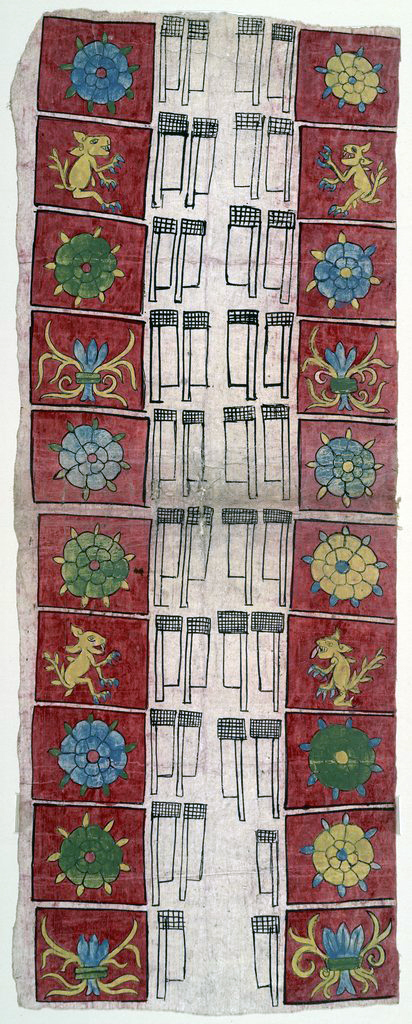
Sheet 4 with textile designs, pigments on amatl paper, made by Huexotzinca artists, before 1531; then combined with written pages to form the Huexotzinco Codex, 1531 (Library of Congress)
On the first page, among the other tribute items you can find wooden planks, lime, and adobe bricks used for construction; 3,600 bundles or pieces of cloth; 32,800 bushels of maize (or even just the cobs); 48,000 chile peppers (or possibly bundles of chiles); and 8,400 chia seeds (or more likely, 8,400 of some specific quantity of chia seeds—they are very tiny!).
Several sheets focus on textiles given as tribute. On one sheet we see a tribute list of different cloths running vertically. Next to each count of cloth is a red rectangle, inside of which can be found a flower or a clawed animal. It is thought that each rectangle is a different type of pattern that could be found on textiles. If these are indeed textile designs intended to be on a red background, it suggests the costliness of the cloths. Red-dyed textiles were expensive, with the color red likely derived from cochineal.
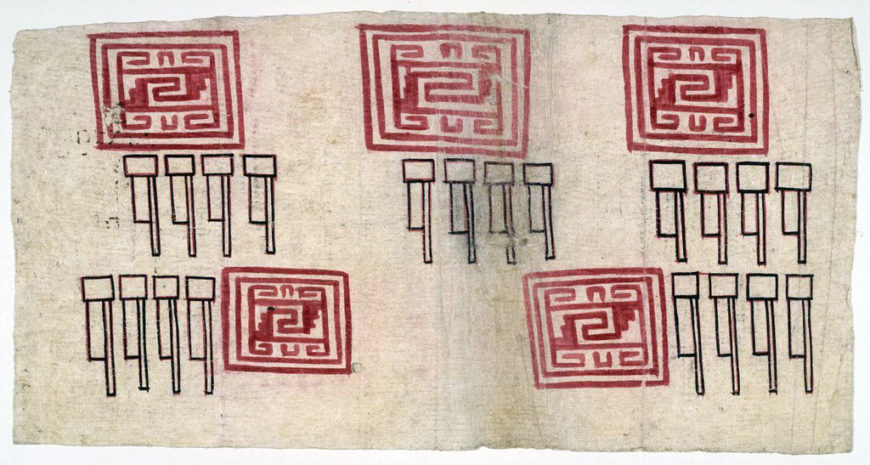
Sheet 5 with possible textile designs, pigments on amatl paper, made by Huexotzinca artists, before 1531; then combined with written pages to form the Huexotzinco Codex, 1531 (Library of Congress)
Another sheet also likely displays different patterns for textiles, this time in a stepped-fret design (what was later called grecas in Spanish). These too are shown in red, indicating yet again the likelihood that they were made with red dye. Other later colonial manuscripts include similar types of images of textile patterns, including the early colonial Codex Magliabechiano. Textiles were a common tribute item before the Spanish invasion, and elaborate ones like these were a sign of wealth. Like so many of the other items shown across these sheets, they also speak to the specialized craft economy that flourished in Mesoamerica.
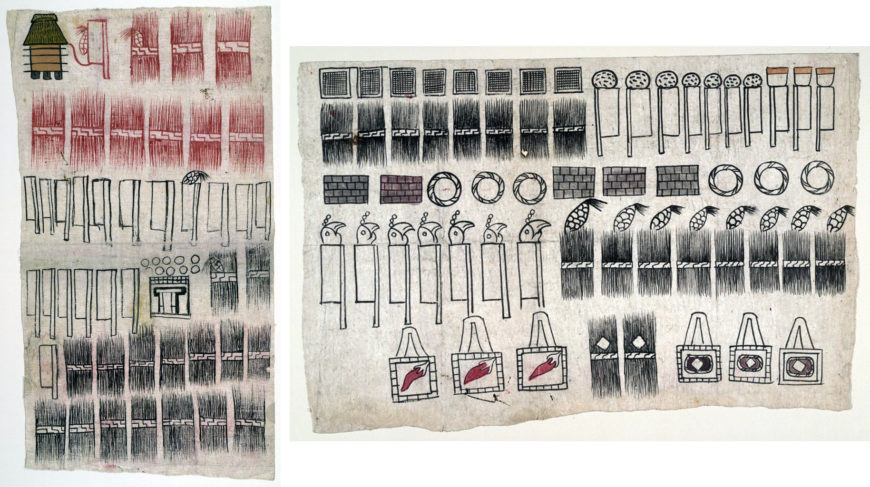
Sheet 3 (right; showing an enormous amount of maize that was to be ground, possibly to feed soldiers embarking on the journey and conquest of Nueva Galicia) and Sheet 6 tribute, pigments on amatl paper, made by Huexotzinca artists, before 1531; then combined with written pages to form the Huexotzinco Codex, 1531 (Library of Congress)
It would take too long to detail all the tribute across all eight sheets. What we do find across the other seven pages are some of the same items, such as turkeys, cloth, maize, and chiles. Some pages also include pots, sandals, bundles of feathers, darts, loincloths, and more. It is an impressive count of goods, and makes one wonder how it was gathered and stored.
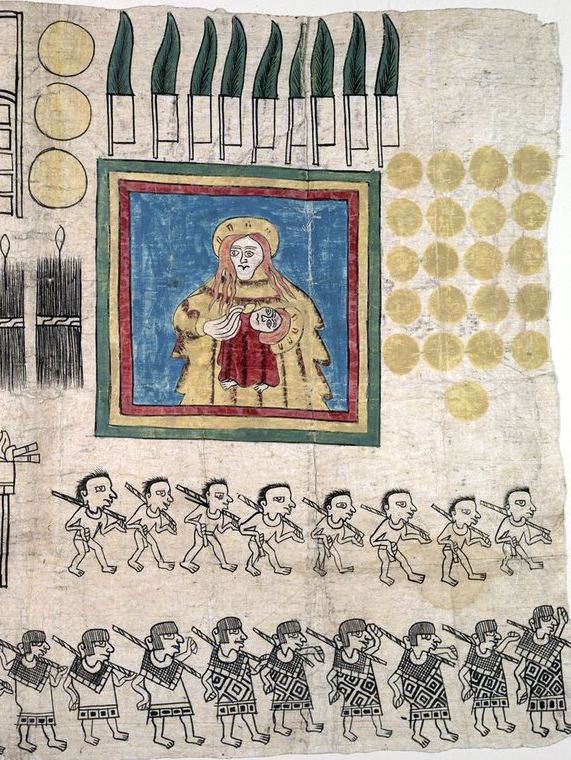
Detail of Sheet 7 of tribute, with a featherwork of the Madonna and Child, pigments on amatl paper, made by Huexotzinca artists, before 1531; then combined with written pages to form the Huexotzinco Codex, 1531 (Library of Congress)
Mary, a featherwork, and a military banner
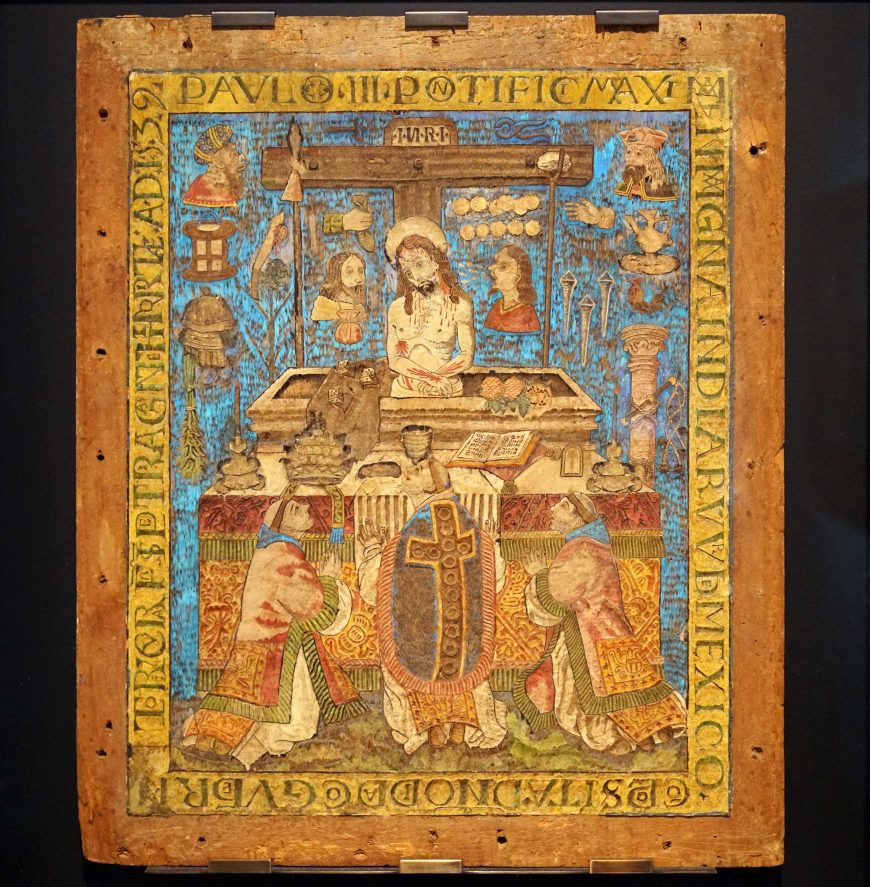
The Mass of St. Gregory, 1539, feathers on wood with touches of paint, 26 1/4 x 22 inches / 68 x 56 cm (Musee des Jacobins)
The image of the Virgin Mary and Child that that we looked at earlier is actually a military banner (or war standard), one that was going to be carried by Guzmán in his efforts to conquer west Mexico. In the written testimonies, the Huexotzinca witnesses noted it was made of feathers and gold. Featherworks had a long history in Central Mexico, and were considered precious items. The Mexica Empire demanded feathers as tribute because of their status as luxury materials. After the Conquest, featherworking traditions continued, albeit with a transformation in subject matter to reflect the desires of Christian colonizers.
The Marian banner displayed in the tribute sheet was apparently so costly that the Huexotzinca had to sell enslaved peoples to produce it—indicated in the painting with the row of enslaved men (wearing maxtlatls) and women (wearing quechquemitls) in different patterns, possibly to indicate where they were from). Selling them permitted artists to buy gold disks, which we see on the right side of the sheet, as well as bunches of smaller feathers and large green feathers. The Marian banner was a large work, measuring half an arm’s length in height and width. The frame was also made of differently colored feathers.
Military banners adorned with Mary were common in Europe, and had been used on the Iberian Peninsula (Spain and Portugal) during the Reconquista. Mary’s associations with conquest (she was sometimes known as la conquistadora, the conqueress) meant that her image was sometimes placed atop hills after defeating a local Mesoamerican population; after the Mexica empire was toppled, an image of Mary was carried as a sign of Spanish triumph. When Guzmán planned to march to west Mexico with his gold and feathered Marian banner he participated in this tradition, and he not only had Spaniards among his forces, but also Huexotzinca who he had forced to fight (as indicated in sheet 8).
Not only is the painting in the Codex the first known Marian image made by an Indigenous artist, but it is the first reference to a Nahua featherwork made with a Christian subject. After the Conquest, missionaries like the Franciscans began to establish schools where they could train Native men to read and write, and to learn European visual techniques and strategies. When the Franciscans arrived in Huejotzingo in 1525 they built the convento of San Miguel Arcangel, which became prominent and eventually did have such a school. It is possible that the featherwork cited in the image was made there.
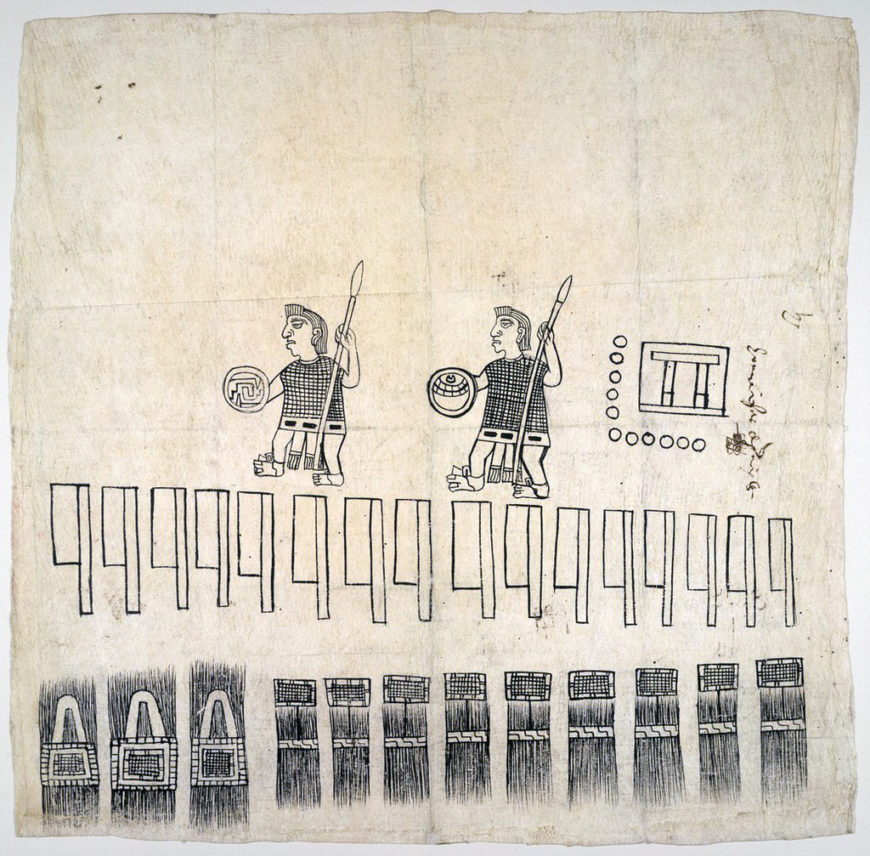
Sheet 8 shows two warriors holding shields and spears next to a date glyph of 11-House (the year 1529 here, and so likely indicating the beginning of the conquest of Nueva Galicia). The banners below the warriors suggest that this is a record of 320 Huexotzinca warriors provided to Guzmán. Sheet 8 of tribute, pigments on amatl paper, made by Huexotzinca artists, before 1531; then combined with written pages to form the Huexotzinco Codex, 1531 (Library of Congress)
Complex entanglements
Other surviving documents from the 16th century tell us that the Huexotzinca continued to speak out against excessive tribute, with a 1560 letter to the Spanish Crown inquiring as to why their tribute had increased more than sevenfold, and once again expressing their frustration given that they had been loyal allies to the Spaniards, had converted to Christianity, had submitted to the Spanish Crown, and always paid their tribute. The earlier eight sheets documenting the tribute paid by the Huexotzinca during Cortés’s absence, like later documents, help to showcase the Huexotzinca’s agency and resiliency, and the complex entanglements that occurred as the viceroyalty of New Spain was established in Central Mexico. The images in the Huexotzinco Codex help us to learn more about tribute, conquest and the conditions of colonialism, Native agency, Nahua writing systems, Indigenous knowledge, the importance of images, early Christianity in the Americas, and legal disputes.
* The Huexotzinco Codex remained in the hands of the heirs of Cortés for hundreds of years, before eventually being sold to a bookdealer and eventually ending up in the Library of Congress in Washington DC (Harkness Collection) where it remains today.
Additional resources:
See the sheets of images from the Huexotzinco Codex on the World Digital Library
The Huexotzinco Codex on The Mapas Project
Read more about the Matrícula de Tributos on Mesolore
Read more about Nahua writing on Mesolore
English Translation of the Harkness 1531 Huejotzingo Codex
Tom Cummins, “From Lies to Truth: Colonial Ekphrasis and the Act of Crosscultural Translation,” in Reframing the Renaissance, ed. Claire Farago (New Haven and London: Yale University Press, 1995), pp. 152–174
Teresa Castelló Yturbide and Manuel Cortina Portilla, The Art of Featherwork in Mexico (Mexico City: Fomento Cultural Banamex, A.C., 1993)
Amy Remensnyder, La Conquistadora: The Virgin Mary at War and Peace in the Old and New Worlds (Oxford: Oxford University Press, 2014)

